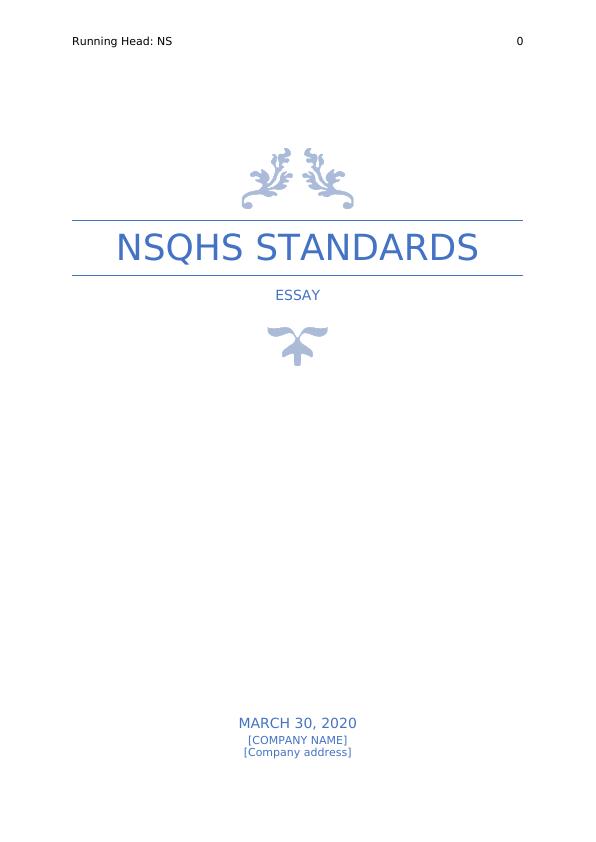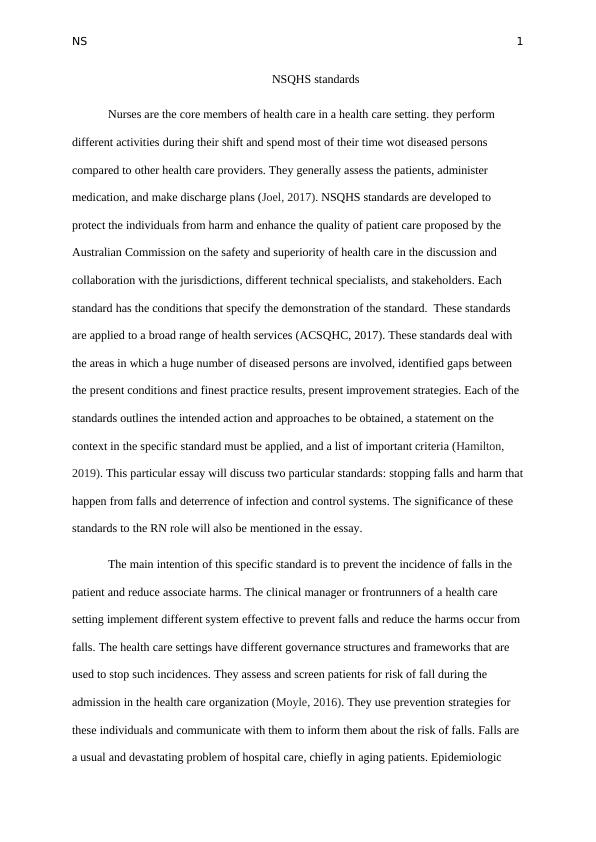Effects of Falls Prevention Interventions
Added on 2022-09-01
10 Pages2804 Words20 Views
Running Head: NS 0
NSQHS STANDARDS
ESSAY
MARCH 30, 2020
[COMPANY NAME]
[Company address]
NSQHS STANDARDS
ESSAY
MARCH 30, 2020
[COMPANY NAME]
[Company address]

NS 1
NSQHS standards
Nurses are the core members of health care in a health care setting. they perform
different activities during their shift and spend most of their time wot diseased persons
compared to other health care providers. They generally assess the patients, administer
medication, and make discharge plans (Joel, 2017). NSQHS standards are developed to
protect the individuals from harm and enhance the quality of patient care proposed by the
Australian Commission on the safety and superiority of health care in the discussion and
collaboration with the jurisdictions, different technical specialists, and stakeholders. Each
standard has the conditions that specify the demonstration of the standard. These standards
are applied to a broad range of health services (ACSQHC, 2017). These standards deal with
the areas in which a huge number of diseased persons are involved, identified gaps between
the present conditions and finest practice results, present improvement strategies. Each of the
standards outlines the intended action and approaches to be obtained, a statement on the
context in the specific standard must be applied, and a list of important criteria (Hamilton,
2019). This particular essay will discuss two particular standards: stopping falls and harm that
happen from falls and deterrence of infection and control systems. The significance of these
standards to the RN role will also be mentioned in the essay.
The main intention of this specific standard is to prevent the incidence of falls in the
patient and reduce associate harms. The clinical manager or frontrunners of a health care
setting implement different system effective to prevent falls and reduce the harms occur from
falls. The health care settings have different governance structures and frameworks that are
used to stop such incidences. They assess and screen patients for risk of fall during the
admission in the health care organization (Moyle, 2016). They use prevention strategies for
these individuals and communicate with them to inform them about the risk of falls. Falls are
a usual and devastating problem of hospital care, chiefly in aging patients. Epidemiologic
NSQHS standards
Nurses are the core members of health care in a health care setting. they perform
different activities during their shift and spend most of their time wot diseased persons
compared to other health care providers. They generally assess the patients, administer
medication, and make discharge plans (Joel, 2017). NSQHS standards are developed to
protect the individuals from harm and enhance the quality of patient care proposed by the
Australian Commission on the safety and superiority of health care in the discussion and
collaboration with the jurisdictions, different technical specialists, and stakeholders. Each
standard has the conditions that specify the demonstration of the standard. These standards
are applied to a broad range of health services (ACSQHC, 2017). These standards deal with
the areas in which a huge number of diseased persons are involved, identified gaps between
the present conditions and finest practice results, present improvement strategies. Each of the
standards outlines the intended action and approaches to be obtained, a statement on the
context in the specific standard must be applied, and a list of important criteria (Hamilton,
2019). This particular essay will discuss two particular standards: stopping falls and harm that
happen from falls and deterrence of infection and control systems. The significance of these
standards to the RN role will also be mentioned in the essay.
The main intention of this specific standard is to prevent the incidence of falls in the
patient and reduce associate harms. The clinical manager or frontrunners of a health care
setting implement different system effective to prevent falls and reduce the harms occur from
falls. The health care settings have different governance structures and frameworks that are
used to stop such incidences. They assess and screen patients for risk of fall during the
admission in the health care organization (Moyle, 2016). They use prevention strategies for
these individuals and communicate with them to inform them about the risk of falls. Falls are
a usual and devastating problem of hospital care, chiefly in aging patients. Epidemiologic

NS 2
investigations have identified that falls happen at a degree of 3–5 every 1000 bed-days, and
the Agency for the Healthcare Investigation and Quality evaluates that particularly in the
United States, 700,000 to one million individuals admitted to the healthcare setting fall
annually. According to a report published by Australia institute of health and welfare (2018),
In 2015–16, there were greater than 34,000 separations in which a diseased person was
treated by health care providers for injuries occurs from a fall in a healthcare setting—a rate
of 3.2 every 1,000 separations. This degree may be undervalued, as a place of incidence was
not detailed for 18 per cent of separations including falls, however, some falls that happened
in health care settings except a hospital are similarly comprised because of the means the
information is coded. The frequency of falls augmented by 0.8 every 1,000 separations
between the year of 2009–10 and 2015–16. This alteration may reflect altering patient
profiles and/or a growing focus on the protection and quality of healthcare settings and
favorable reporting of pertinent data throughout this period. It can help the healthcare
organization to prevent falls and associated injuries and increase hospitalization Australia
institute of health and welfare (2018). This standard required healthcare organizations to
implement and maintain systems to avoid falls by including screening or assessing
individuals with falls risk and use multifactorial falls deterrence strategies. It requires an
organization to develop policies that enable health care providers to report and record fall
cases and focus more on elderly people as they have a high risk of falls. Implementation of
this standard can lead to improved standardized processes and a chance for knowledge
sharing within the health services (McKechnie, Pryor & Fisher, 2017).
Nurses can play a key role in the deterrence of falls and associated injuries and
implement systems. They are equipped with different skills such as treatment, prevention,
education, promotion, advocacy for the admitted individual and their families. They also have
skills like effective communication skills, empathy, having knowledge of different cultures,
investigations have identified that falls happen at a degree of 3–5 every 1000 bed-days, and
the Agency for the Healthcare Investigation and Quality evaluates that particularly in the
United States, 700,000 to one million individuals admitted to the healthcare setting fall
annually. According to a report published by Australia institute of health and welfare (2018),
In 2015–16, there were greater than 34,000 separations in which a diseased person was
treated by health care providers for injuries occurs from a fall in a healthcare setting—a rate
of 3.2 every 1,000 separations. This degree may be undervalued, as a place of incidence was
not detailed for 18 per cent of separations including falls, however, some falls that happened
in health care settings except a hospital are similarly comprised because of the means the
information is coded. The frequency of falls augmented by 0.8 every 1,000 separations
between the year of 2009–10 and 2015–16. This alteration may reflect altering patient
profiles and/or a growing focus on the protection and quality of healthcare settings and
favorable reporting of pertinent data throughout this period. It can help the healthcare
organization to prevent falls and associated injuries and increase hospitalization Australia
institute of health and welfare (2018). This standard required healthcare organizations to
implement and maintain systems to avoid falls by including screening or assessing
individuals with falls risk and use multifactorial falls deterrence strategies. It requires an
organization to develop policies that enable health care providers to report and record fall
cases and focus more on elderly people as they have a high risk of falls. Implementation of
this standard can lead to improved standardized processes and a chance for knowledge
sharing within the health services (McKechnie, Pryor & Fisher, 2017).
Nurses can play a key role in the deterrence of falls and associated injuries and
implement systems. They are equipped with different skills such as treatment, prevention,
education, promotion, advocacy for the admitted individual and their families. They also have
skills like effective communication skills, empathy, having knowledge of different cultures,

End of preview
Want to access all the pages? Upload your documents or become a member.
Related Documents
Roles of Nurses in Minimizing Hospital Based Falls: A Critical Analysislg...
|13
|2827
|465
Reflection on NSQHS Standards: Medication Safety and Infection Controllg...
|6
|1488
|269
NURS4001 Nursing and Midwifery Capstone Project 2022lg...
|14
|2919
|23
Prevention of Fall in Adult Patientslg...
|13
|4978
|15
HEALTH CARE 8 HEALTH CARE Health care Name of the student: Nosocomial Infeasibility in Health Carelg...
|11
|3105
|273
Teaching, Learning & Leadershiplg...
|13
|2600
|19
